• Flaggen
• historische Flaggen
• Bedeutung/Ursprung der Flagge
• Wappen
• Bedeutung/Ursprung des Wappens
• Flugzeugkokarde
• Landkarte
• Zahlen und Fakten
• Geschichte
• Ursprung des Landesnamens
• Bougainville
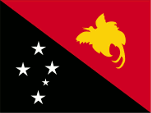
Nationalflagge und Gösch,
Seitenverhältnis = 3:4,
Quelle, nach: Flags of the World





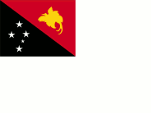
Marineflagge,
Seitenverhältnis = 3:4,
Quelle: Flags of the World



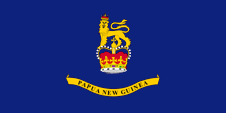
Flagge des Generalgouverneurs,
Seitenverhältnis = 1:2,
Quelle: Flags of the World




Neuguinea:
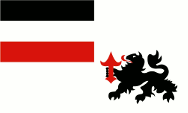
1885–1899,
Flagge der Deutschen Neuguinea-Kompagnie,
Quelle, nach: Flags of the World



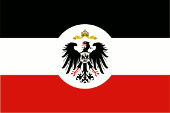
1899–1914,
Deutsches Reich,
Dienstflagge Kolonialamt,
Seitenverhältnis = 2:3,
Quelle, nach: Wikipedia (DE)





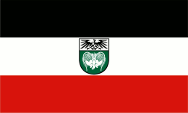
1914,
geplante Flagge für Deutsch-Neuguinea,
Seitenverhältnis = 3:5,
Quelle: Flags of the World,
Flag Reconstruction following Mark Sensen (Feb 98)
based on traditional interpretation from Afrika-Nachrichten article 1933



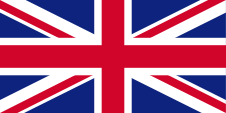
1914–1920,
Flagge Großbritanniens,
Seitenverhältnis = 1:2,
Quelle, nach: Wikipedia (EN)





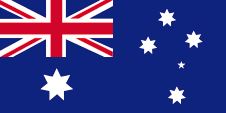
1920–1949,
Australisch-Neuguinea,
Nationalflagge von Australien,
Seitenverhältnis = 1:2,
Quelle, nach: Flags of the World





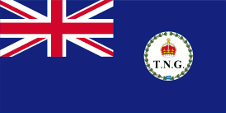
1921–1949,
Australisch-Neuguinea,
Flagge des Adminstrators,
Seitenverhältnis = 1:2,
Quelle, nach: Flags of the World



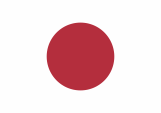
1942–1945,
Neuguinea ist von Japan besetzt,
Seitenverhältnis = 7:10,
Quelle, nach: Wikipedia (EN)





Papua:
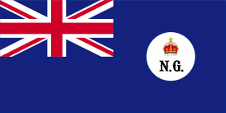
1884–1906,
Britsches Neuguinea-Territorium,
Flagge der Regierung (Staatsflagge),
Seitenverhältnis = 1:2,
Quelle, nach: Flags of the World



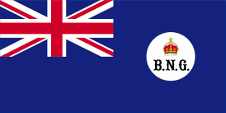
1888–1906,
Britsches Neuguinea-Territorium,
Flagge der Regierung (Staatsflagge),
mögliche Variante,
Seitenverhältnis = 1:2,
Quelle, nach: Flags of the World



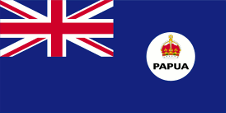
1906–1949,
Australisches Papua-Territorium,
Flagge der Regierung (Staatsflagge),
Seitenverhältnis = 1:2,
Quelle, nach: Flags of the World



Papua-Neuguinea:

1949–1970,
Territorium Papua und Neuguinea,
Nationalflagge von Australien,
Seitenverhältnis = 1:2,
Quelle, nach: Flags of the World





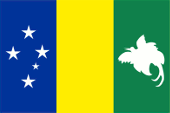
1970–1971,
Territorium Papua und Neuguinea,
Nationalflagge,
Seitenverhältnis = 2:3,
Quelle, nach: Flags of the World




1971–1975,
Territorium Papua und Neuguinea,
Nationalflagge,
Seitenverhältnis = 3:4,
Quelle, nach: Flags of the World






Die heutige Flagge von Papua-Neuguinea wurde am 12.03.1971 (nach anderen Quellen erst am 01.07.1971) offiziell eingeführt. Sie zeigt ein in zwei rechtwinklige Dreiecke geteiltes Feld, im rechten roten Dreieck einen gelben Paradiesvogel, im schwarzen Feld ein "Kreuz des Südens" aus weißen Sternen. Die Farben der Flagge sind offenbar nicht besonders definiert, zumindest ist nichts dazu bekannt. In der Praxis werden ein kräftiges Rot und ein kräftiges Gelb verwendet, wobei sie die Farben an das britische Farbsystem anzulehnen scheinen: Pantone 116 für Gelb und Pantone 168 für Rot. Papua-Neuguinea orientiert sich am britschen Ensign-System. Das weißt auf die frühere Verbindung zu Großbritannien hin. Großbritannien hatte in Jahr 1864 ein Flaggensystem eingeführt, in dem:
• Kriegsschiffe einen sogenannten "White Ensign" (Marineflagge), eine weiße Flagge oft mit durchgehendem roten Georgskreuz und mit dem Union Jack in der Oberecke,
• Handelsschiffe einen "Red Ensign" (auch "Civil Ensign" → Bürgerflagge genannt, die eigentl. Handelsflagge), eine rote Flagge mit dem Union Jack in der Oberecke, und
• Dienstschiffe einen "Blue Ensign" (Regierungsflagge → die eigentl. Staatsflagge), eine blaue Flagge mit dem Union Jack in der Oberecke führten.
Seit 1865 durften Schiffe von Kolonialregierungen einen Blue Ensign mit einem Badge (Abzeichen) im fliegenden Ende führen. Die jeweiligen Regierungen sollten entsprechene Bagdes zur Verfügung stellen. Handelsschiffe und seefahrende Privatpersonen aus Kolonien dürfen nur dann einen Red Ensign mit Badge führen, wenn von der britischen Admiralität eine entsprechende Erlaubnis erteilt wurde.
Der Paradiesvogel wurde einst von den Deutschen als Wappenfigur eingeführt. Er steht für die Einheit des Landes. Das "Kreuz des Südens" ist ein altes, weit verbreitetes traditionelles Wahrzeichen Ozeaniens. Es wurde wahrscheinlich von der Flagge Australiens übernommen. Die Farben Rot und Schwarz entstammen der regionalen Volkskunst, und sind im Lande weit verbreitet. Papua-Neuguinea bestand früher aus zwei Landesteilen. Im Norden Neuguinea und im Süden Papua. Papua wurde am Ende des 19. Jahrhunderts von Großbritannien kolonisiert, und 1884 die erste Flagge eingeführt. Es war ein wie bei britischen Kolonien seit 1864 üblicher "Blue Ensign", die blauen Dienstflagge mit einem Abzeichen (Badge) im wehenden Ende der Flagge. Dieses Abzeichen war eine weiße Scheibe mit der britischen Krone und den Buchstaben "N.G." darin. Diese Abkürzung stand für "New Guinea" → Neuguinea. Wahrscheinlich ab 1888 laute die Inschrift "B.N.G.". Diese Abkürzung stand für "British New Guinea" → Britisch-Neuguinea. Ab 1906 laute die Inschrift "Papua". Britisch-Neuguinea (Papua) war 1905 von Großbritannien an Australien übergeben worden. Neuguinea kam unter deutschen Einfluss und wurde anfänglich von der Deutschen Neuguinea-Kompagnie verwaltet, und im Lande wurde die Flagge dieser Handelsgesellschaft verwendet. Nach wirtschaftlichen Problemen übernahm 1899 das Deutsche Reich die Verwaltung. Als deutsche Kolonie verwendete das Land keine besondere Nationalflagge. Es galten die Farben des Deutschen Reiches: Schwarz, Weiß und Rot. Behörden verwendeten die Flagge des Kolonialamtes sowie Abarten davon. Diese war zwar schwarz, weiß und rot waagerecht gestreift und zeigte in der Mitte eine weiße Scheibe mit dem Reichsadler. Ab 1913 wurde überlegt, für die Kolonien eigene Hoheitszeichen zu schaffen. Erste Entwürfe lagen 1914 vor, jedoch wurde das Projekt wegen des Ausbruchs des Ersten Weltkriegs und wegen des Verlusts der Kolonien nicht mehr realisiert. Deutsch-Neuguinea wurde 1914 von britisch-australischen Truppen besetzt, und eine britische Verwaltung eingerichtet. Im Jahre 1920 wurde Deutsch-Neuguinea als Mandatsgebiet des Völkerbundes an Australien übergeben. Es wurde die australische Flagge eingeführt. Es gab noch einen "Blue Ensign" mit einem Badge im wehenden Ende der Flagge. Dieses Abzeichen war eine weiße Scheibe mit einem grünen Kranz am Rand mit der britischen Krone und den Buchstaben "T.N.G." darin. Diese Abkürzung stand für "Territorry of New Guinea" → Neuguinea-Territorium. Dies war wahrscheinlich die Flagge des Administators des Territoriums. Im Zweiten Weltkrieg wurde Neuguinea im Jahre 1942 von Japanischen Truppen besetzt, und bis zur Kapitulation Japans am 02.09.1945 größtenteils gehalten. Nach dem Zweiten Weltkrieg (1949) wurde Neuguinea mit Papua unter australischer Verwaltung vereinigt. Es wurde nur noch die Flagge Australiens verwendet, wenn auch einige Behörden alte "Blue Ensigns" oder Varianten der australischen Flagge verwenden durften. Seit 1962 gab es eine inoffizielle Flagge, die lediglich bei Sportveranstaltungen verwendet wurde. Ansonsten war sie weder zugelassen noch national oder international anerkannt. Sie war einfarbig grün und zeigte in der am Mast gelegenen Hälfte der Flagge einen Paradiesvogel. Im Jahre 1970 wurde ganz offiziell die erste eigene Flagge für Papua-Neuguinea eingeführt. Sie zeigte drei senkrechte Streifen in Blau, Gelb und Grün, im blauen Streifen das "Kreuz des Südens" und im grünen Streifen einen Paradiesvogel. Sie durfte nur an Land verwendet werden. Jedoch fand diese Flagge in der Bevölkerung keinen Rückhalt. Die Schülerin Susan Karike schuf dann die heutige Flagge, welche 1971 angenommen und bald sehr beliebt wurde. Auch diese Flagge durfte nur an Land verwendet werden. Diese Flagge wurde im Jahre 1975 als Flagge des unabhängigen Staates Papua-Neuguinea übernommen.
Quelle:
Flaggen Wappen Hymnen,
Flaggen und Wappen der Welt,
Wikipedia (EN)

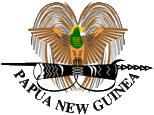
Wappen von Papua-Neuguinea,
Quelle:
Corel Draw 4

1914,
geplantes Wappen von Deutsch-Neuguinea,
Quelle: Flags of the World, Flag Reconstruction following Mark Sensen (Feb 98)
based on traditional interpretation from Afrika-Nachrichten article 1933

Das heutige Staatswappen wurde im Juni 1971 eingeführt. Es zeigt an zentraler Position einen Paradiesvogel. Er sitzt auf zwei für Zeremonien wichtigen Gegenständen, einer schwarzen Kundu-Trommel ("Koendoedrum") und einem schwarzen Speer. Darunter der Name des Landes, ebenfalls in Schwarz. Der Paradiesvogel wurde einst von den Deutschen als Wappentier eingeführt. Er steht für die Einheit des Landes. Neuguinea war einst eine deutsche Kolonie. Die deutschen Kolonien unterstanden – Kiautschou ausgenommen – dem Reichskolonialamt. Entsprechend verwendeten Behörden dessen Siegel, Flaggen und das Reichswappen. Ab 1913 wurde überlegt, für die Kolonien eigene Hoheitszeichen zu schaffen. Erste Entwürfe lagen 1914 vor, jedoch wurde das Projekt wegen des Ausbruchs des Ersten Weltkriegs und wegen des Verlusts der Kolonien nicht mehr realisiert. Das geplante Wappen von Deutsch-Neuguinea zeigte einen weißen Paradiesvogel auf grünem Grund. Das gedachte Aussehen der Wappen und Flaggen konnte in den 20er und 30er Jahren des 20. Jahrhunderts anhand von Fragmenten lediglich rekonstruiert werden. Die meisten Rekonstruktionen beziehen sich auf einen Artikel der Zeitung "Afrika-Nachrichten" von 1933 und die daraus folgenden Rekonstruktionen des niederländischen Vexillologen Mark Sensen vom Februar 1998, die auch auf diesen Seiten berücksichtigt werden. Die Wappen selbst sollten oberhalb des Wappenschilds noch die Kaiserkrone tragen, jedoch nicht auf den Flaggen, wenn man der Rekonstruktion von Mark Sensen folgt. Die Wappenschilde zeigten immer den gleichen Aufbau: Ein horizontal zweigeteiltes Schild, dessen Schildhaupt auf weiß den Reichsadler mit dem Brustschild des Hauses Hohenzollern zeigte. Im Hauptteil eine stilisierte Darstellung von Pflanzen, Tieren oder Landschaften, die je nach Land unterschiedlich gefärbt waren.
Quelle:
Flaggen Wappen Hymnen,
Flaggen und Wappen der Welt,
Flags of the World

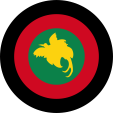
Flugzeugkokarde,
Quelle/Source, nach/by: Wikipedia (EN)

Lage:
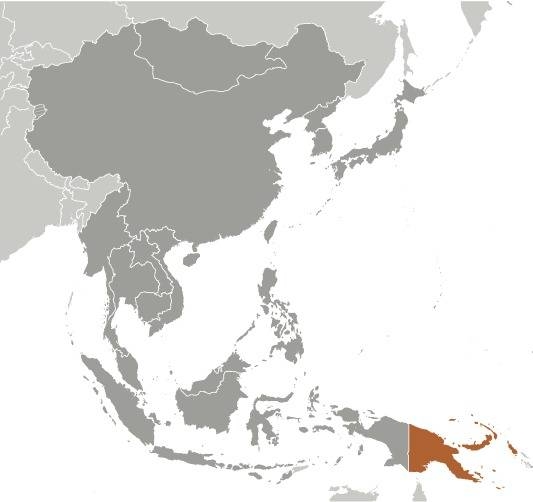
Quelle/Source: CIA World Factbook
Landkarte des Landes:
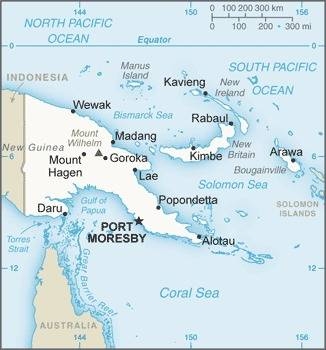
Quelle/Source: CIA World Factbook
Neuguinea (blau) & Papua (rot) – 1894:

Quelle: Brockhaus, Public domain, via Wikimedia Commons, zum Vergrößern klicken

Fläche: 462.840 km², davon Papua 234.498 km², Neuguinea 240 870 km²
Einwohner: 9.700.000 (2020), meist Papua, ferner Austronesier, Chinesen und auch einige Europäer
Religionen: 26% Katholiken, 18% Protestanten, 45% andere Christen
Bevölkerungsdichte: 21 Ew./km²
Hauptstadt: Port Moresby, 364.125 Ew. (2011)
Amtssprachen: Englisch, Hiri Motu, Tok Pisin
sonstige Sprachen: Papuasprachen, Austronesische Sprachen, Unserdeutsch
Währung: 1 Kina (PGK, Ki) = 100 Toea
Zeitzone: MEZ + 9 h
Quelle:
Wikipedia (D),
Die Erde

1526 · Entdeckung der Insel Neuguinea durch den portugiesischen Seefahrer Jorge de Meneses
1545 · der spanische Seefahrer Ynigo Ortiz de Retez landet auf der Insel Neuguinea und erforscht die Küste und nimmt sie für Spanien in Besitz, in der Folgezeit unbedeutende spanische Kolonisierung
1828 · Inbesitznahme des westlichen Teils der Insel Neuguinea durch die Niederlande (als Westirian bis 1963 zu Niederländisch-Westindien, ab 1963 zu Indonesien)
Neuguinea
(eigentlich Nordostneuguinea)
1860 · erste deutsche Handelsniederlassungen (Firma Godeffroy) an der Küste Neuguineas, später 45 Filialen in der ganzen Südsee
1882 · Zusammenbruch der Firma Godeffroy, die "Deutsche Handels- und Plantagengesellschaft der Südsee" übernimmt die Geschäfte
1882 · Gründung der Neuguinea-Kompanie
1884 · der deutsche Ethnologe und Ornithologe Otto Finsch bereist Neuguinea, Inbesitznahme von Teilen der Küste von Neuguinea für die Neuguinea-Kompanie
1885 · die Neuguinea-Kompanie erhält mit einen Schutzbrief des Deutschen Reiches umfangreiche Hoheitsrechte zur Erschließung und Verwaltung des Nordostens von Neuguinea (Kaiser-Wilhelms-Land und Bismarck-Archipel), 1886 kamen noch die Nord-Salomonen dazu
1885 · offizielle Aufteilung des östlichen Teils von Neuguinea zwischen dem Deutschen Reich (Nordteil, Neuguinea) und Großbritannien (Südteil, Papua), Neuguinea wird in "Kaiser-Wilhelms-Land" umbenannt, und die gesamte Kolonie (einschließlich des Bismarck-Archipels) der Neuguinea-Kompanie unterstellt
1899 · die Neuguinea-Kompagnie kommt in finanzielle Schwierigreiten, das Deutsche Reich übernimmt die Souveränität über die Kolonie (Deutsch Neu-Guinea)
1914–1918 · Erster Weltkrieg: Invasion Britisch-Australischer Truppen, 17.09.1914 Kapitulation der deutschen Truppen im Regierungssitz Herbertshöhe (heute Kokopo)
1920 · Deutsch-Neuguinea wird als Mandatsgebiet des Völkerbundes an Australien übergeben, Enteigung und Vertreibung der meisten Deutschen aus Neuguinea
Dezember 1941 · Zweiter Weltkrieg, Eroberung durch Japanische Truppen
02.09.1945 · Kapitulation der Japanischen Truppen
1946 · Auflösung des Völkerbunds, Neuguinea wird UNO-Treuhandgebiet unter australischer Verwaltung
Papua
(eigentlich Südostneuguinea)
06.11.1884 · Bildung des Protektorats Britisch-Neuguinea
04.09.1888 · Inbesitznahme von Britisch-Neuguinea durch Großbritannien
1902 · Britisch-Neuguinea wird an Australien übergeben
1905 · Umbenennung von Britisch-Neuguinea in Papua-Territorium
Papua-Neuguinea
1949 · Neuguinea und Papua werden unter australischer Verwaltung zu Papua-Neuguinea vereinigt
Dezember 1973 · innere Selbstverwaltung
seit 1974 · starke Umweltzerstörung durch die Mine Panguna auf der Insel Bougainville
16.09.1975 · Papua-Neuguinea wird unabhängig im Rahmen des Commonwealth of Nations
10.10.1975 · Papua-Neuguinea wird Mitglied der UNO
1979 · erste Unruhen auf Bougainville gegen die Umweltzerstörung durch die Mine Panguna
1980 · Bürgerkrieg auf Bougainville, die Befreiungsarmee von Bougainville (BRA, Bougainville Revolutionary Army) kämpft für die Unabhängigkeit der Insel
1990 · Bougainville erklärt seine Unabhängigkeit (Republik Mekamui), die Mine Panguna wird geschlossen, eine Blockade durch Papua-Neuguinea fordert 15.000 Menschenleben
1994 · Heftige Vulkanausbrüche, Zerstörung von Rabaul, Waffenstillstand zwischen Papua-Neuguinea und Bougainville
1996 · Verhandlungen zwischen Papua-Neuguinea und Bougainville werden abgebrochen, Offensive Papua-Neuguineas gegen Bougainville
1997 · Unruhen in Papua-Neuguinea, Waffenstillstand zwischen Papua-Neuguinea und Bougainville
1998 · vorläufiger Friedensvertrag zwischen Papua-Neuguinea und Bougainville
2001 · Friedensvertrag, Papua-Neuguinea gewährt offiziell Autonomie als Autonome Region Bougainville
Quelle:
Atlas zur Geschichte,
Weltgeschichte,
Wikipedia (D)

Der Name "Papua" wurde der Insel angeblich von Jorge de Meneses verliehen. Er verwendete dabei ein malaiisches Wort. Es bedeutet "kraus" und bezog sich auf die Haare der Ureinwohner. Der Name "Neuguinea" wurde der Insel von Ynigo Ortiz de Retez verliehen, da ihn die Küste stark an die Küste von Guinea (Westafrika) erinnerte.
Quelle: Handbuch der geographischen Namen


![]()







































![]()
